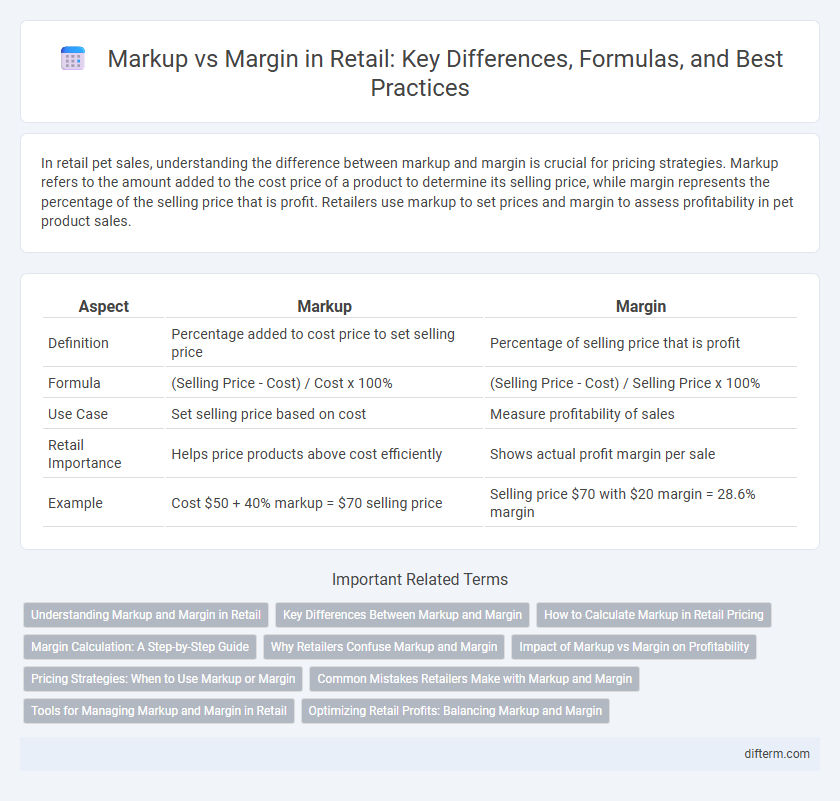In retail pet sales, understanding the difference between markup and margin is crucial for pricing strategies. Markup refers to the amount added to the cost price of a product to determine its selling price, while margin represents the percentage of the selling price that is profit. Retailers use markup to set prices and margin to assess profitability in pet product sales.
Table of Comparison
| Aspect | Markup | Margin |
|---|---|---|
| Definition | Percentage added to cost price to set selling price | Percentage of selling price that is profit |
| Formula | (Selling Price - Cost) / Cost x 100% | (Selling Price - Cost) / Selling Price x 100% |
| Use Case | Set selling price based on cost | Measure profitability of sales |
| Retail Importance | Helps price products above cost efficiently | Shows actual profit margin per sale |
| Example | Cost $50 + 40% markup = $70 selling price | Selling price $70 with $20 margin = 28.6% margin |
Understanding Markup and Margin in Retail
Markup represents the percentage added to the cost price to determine the selling price, while margin indicates the percentage of the selling price that is profit. Retailers use markup to set prices and margin to evaluate profitability, making both critical for pricing strategy and financial analysis. Understanding the precise calculation of markup and margin helps optimize pricing decisions and improve retail profit margins.
Key Differences Between Markup and Margin
Markup represents the percentage added to the cost price to determine the selling price, while margin reflects the percentage of the selling price that is profit. In retail, markup is calculated as (Selling Price - Cost) / Cost, whereas margin is calculated as (Selling Price - Cost) / Selling Price. Understanding these key differences helps retailers accurately price products and analyze profitability.
How to Calculate Markup in Retail Pricing
Markup in retail pricing is calculated by subtracting the cost price from the selling price, then dividing the result by the cost price, and multiplying by 100 to express it as a percentage. For example, if the cost price is $50 and the selling price is $75, the markup percentage is ((75 - 50) / 50) * 100 = 50%. Understanding the difference between markup and margin is crucial, as markup is based on cost, while margin is based on selling price.
Margin Calculation: A Step-by-Step Guide
Margin calculation involves determining the percentage of sales revenue that exceeds the cost of goods sold, essential for assessing retail profitability. To calculate margin, subtract the cost price from the selling price, then divide the result by the selling price and multiply by 100 to get the margin percentage. Accurate margin analysis guides pricing strategies and inventory decisions in retail businesses.
Why Retailers Confuse Markup and Margin
Retailers often confuse markup and margin because both relate to pricing and profitability but measure different financial aspects; markup is based on cost, while margin is based on selling price. This misunderstanding leads to pricing errors, affecting profit calculations and business decisions. Clear differentiation improves inventory pricing strategies and ensures accurate financial reporting.
Impact of Markup vs Margin on Profitability
Markup directly affects pricing strategy by determining the percentage added to the cost price, influencing sales volume and competitive positioning. Margin reflects the actual profitability of products or services, representing the percentage of sales revenue remaining after covering costs. Understanding the distinction between markup and margin enables retailers to optimize profit margins, manage inventory pricing effectively, and improve overall financial performance.
Pricing Strategies: When to Use Markup or Margin
Markup improves pricing strategies by calculating price based on cost to ensure profit margins are met, especially effective for cost-plus pricing models in retail. Margin focuses on profit percentage relative to sales price, ideal for assessing profitability and aligning pricing with competitive market rates. Retailers should use markup when setting straightforward price increases from cost and margin when analyzing overall profitability and price elasticity.
Common Mistakes Retailers Make with Markup and Margin
Retailers often confuse markup and margin, leading to pricing errors that impact profitability; markup is the percentage added to cost price, while margin is the percentage of the selling price that is profit. A common mistake is setting prices based on markup without considering the desired margin, which can result in underpricing or overpricing products. Failure to distinguish these concepts can distort financial analysis and misguide inventory and sales strategies.
Tools for Managing Markup and Margin in Retail
Retailers use advanced pricing software and analytics tools to manage markup and margin effectively, enabling real-time adjustments based on sales performance and market trends. Inventory management systems integrate margin tracking to optimize product pricing strategies and identify high-margin items. Cloud-based dashboards provide comprehensive reports on markup percentages and gross profit margins, helping retailers make data-driven decisions to maximize profitability.
Optimizing Retail Profits: Balancing Markup and Margin
Optimizing retail profits requires a clear understanding of the difference between markup and margin, where markup represents the percentage added to the cost price and margin indicates the percentage of sales price that is profit. Retailers achieve balanced profitability by setting a strategic markup that covers operational expenses while maintaining a competitive margin to attract customers. Utilizing data analytics for pricing strategies enables precise adjustments to maximize profit without sacrificing sales volume.
Markup vs Margin Infographic

 difterm.com
difterm.com